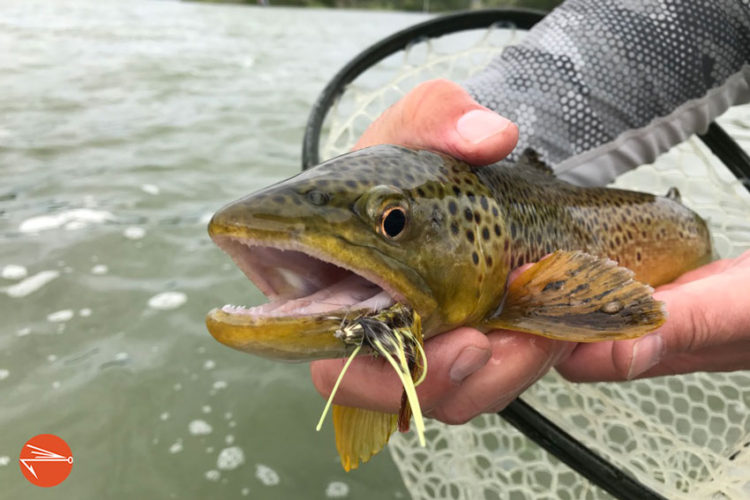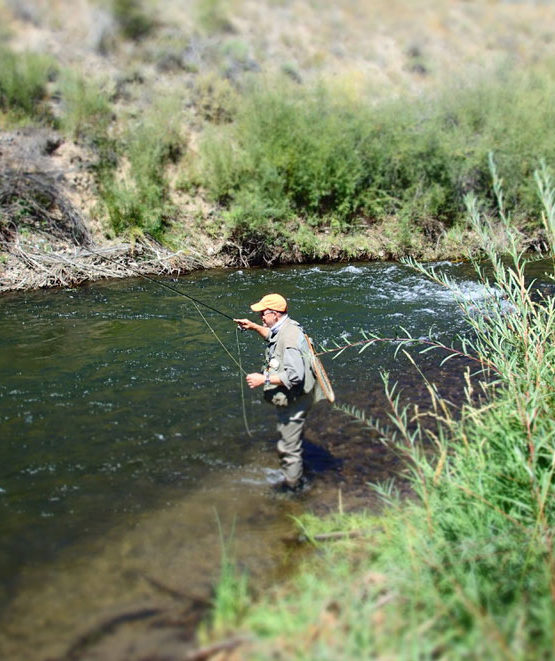Streamer fishing can be one of the most exciting and effective ways to catch big fish with a fly rod.
That said, learning to fish with a streamer can be one of the more difficult techniques in all of fly fishing.
Fortunately, in this article, we’re going to cover 7 basic tips that will help you master the art of fishing with streamers, and once you have, you will have opened up a whole new way to catch fish when other methods are not producing.
Let’s get to it!
1. Comb The Banks
If you’ve ever walked along the side of a river or lake, you’ve probably noticed small schools of minnows swimming around.
Why?
Because the combination of the bank and the shallow, slow-moving water provides the perfect environment for little fish to thrive.
The only problem (for said little fish) is that these little fingerlings make for an easy meal for bigger, hungry trout–who also like to take advantage of the protection the bank provides.
With that in mind, whenever you tie a streamer to the end of your line, you should focus a large percentage of your casts hard into the banks.
And when I say cast to the bank, I mean cast as close to the bank as you possibly can–especially if you’re in a river.
Seriously, if you can land your streamer within a couple inches of the edge of a river, or even better, on the first few inches of the bank and then strip it immediately into the river’s flow, your chances of catching a fish dramatically improve.
Want to improve your fly fishing skills and catch more fish? We think you’ll love these other posts:
- What Do Trout Eat? (The Ultimate Guide)
- How To Cast In The Wind: 7 Simple Tips
- 10 Fly Fishing Accessories Every Angler Should Own
- 12 Killer Foam Flies You Need To Try
- Fly Fishing Fast Water: 7 Tips To Land More Fish
- 7 Fly Casting Techniques Every Angler Should Learn
- 25 Proven Tips To Catch More Trout
2. Use A Sinking Leader
In fly fishing, you will be using a floating line most of the time. These lines are extremely versatile, easy to use, and the best choice for most fly fishing applications.
But there are times–especially when you’re streamer fishing–when you need your rig to sink faster than a floating leader will allow.
In these cases, it pays to use a sinking leader.
Sinking leaders will allow you to reach depths that you might otherwise not get to without the addition of weights. In fact, when you’re fishing with streamers, I recommend using a sinking leader as often as possible .
Not only will this eliminate the need for weights (which you should generally avoid when fishing with streamers), but it will keep your heavy streamer rig simple and easy to manage.
In even better news, sinking leader tends to be stronger than regular leader and tippet, so when that exciting, make-you-wet-your-pants attack comes, it’s less likely that a ticked-off brown trout will break you off in the fight.
3. Try Sight Casting
There are few things as fun as watching an angry fish chase after and hammer a streamer.
Therefore, like any other type of fly fishing, if you spot a fish in the water, try sight-casting to it.
In fact, I highly recommend wearing a good pair of polarized glasses in order to have better visibility in the water. These will help fight glare from the sun and reflections from other objects on the water so that you can see fish better under the surface.
If you’re fishing on a river, I recommend casting well upstream of your target and letting your streamer swing directly in front of the fish. From there, strip the streamer upstream and watch for the attack.
On the other hand, if you’re fishing still water, I recommend casting beyond your target and stripping your streamer so that it nearly hooks the fish on the way by.
Then, if the fish takes notice of your streamer, keep it interested by stripping your line in short, twitchy intervals.
And that brings me to my next point…
4. Make It Swim, Twitch, and Wiggle
When fishing with a streamer, you want to make it imitate the behavior of a minnow as much as you possibly can.
After all, the more lifelike that you can make your streamer look, the more likely the fish are to hammer it.
There are a few different ways that you can achieve this, and one of the best is to strip your streamer upstream at different intervals. Experimenting with the timing and amount of line will allow you to find what works best.
Then again, don’t be afraid to throw in a few random twitches and jerks throughout the process, as these kinds of erratic movements can draw a little extra attention to your fly.
Give it a try next time on the water, and mix it up from quick, short twitches to long, smoother motions to see which different methods are working for the fish in your area.
Sometimes all it will take is a little bit of experimentation and patience to find that perfect technique.
5. Stick With It
Streamer fishing can be intimidating–especially if you’re a beginner.
Beyond that, it’s common for anglers to get frustrated after a short amount of time with streamers.
The best thing that you can do is to stick with it, even if you’re not having a lot of early success.
Trust me, it will get easier. Eventually, it might even become the most effective technique in your fly fishing repertoire, and your most favorite.
I speak from personal experience in saying that stripping streamers has salvaged many a slow day when other techniques just weren’t working.
6. Try An Articulated Streamer
We have already talked about how important it is to make your streamer look as lifelike as possible.
What if there was a way you could make your streamers appear even more life-like than they already do?
Well, there is, and you should try articulated streamers to get even more motion and action in the water.
Articulated streamers are just like they sound.
The way they are tied features added dual-segmented articulation in the body of the fly. This fly-tying technique accentuates subsurface motion to better mimic a swimming underwater entity.
In addition to greater movement, articulated streamers are generally bigger, more natural looking, and, thus, present themselves as an unavoidable protein-packed opportunity for hungry trout.
Combine a larger target with the realistic movements and you have the perfect recipe for catching stubborn fish when nothing else seems to be drawing fire.
7. Pick The Right Colored Streamer
Last but certainly not least, in order to ensure the greatest potential for success with a streamer, you’ll want your streamers to imitate the correct colors.
As a general rule of thumb, stick to darker patterns such as blacks, browns, and purples on days when it’s dark or cloudy. Your main goal here is to create a minnow-like silhouette to catch the attention of a nearby fish.
On the other hand, when the sun is out, try brighter-colored or white streamers, as they tend to reflect the sunlight and draw a lot of action.
This applies to water clarity as well; brighter colors excel in clear water, while dark colors work best in muddy or murky water.
Of course, rules are made to be broken, so try different colors, patterns and techniques.
Trust me, if you land on something your finned quarry are excited to maul on a particular day, your fly fishing enjoyment, nay, addiction will find new heights.
Final Thoughts
Streamer fishing is one of the most challenging and exciting skills you can learn as an angler.
Not only is it one of the most effective fly fishing techniques, but it can lead to some of the strongest takes, biggest fish, and most fun moments you’ll ever enjoy with a fly rod in hand.
Just remember, while it can be tricky and frustrating to learn, with enough practice and time on the water, streamer fishing might just become your favorite way to fly fish.
Disclaimer: This post may contain affiliate links, meaning we will receive a small commission (at no cost to you) if you click through and make a purchase.










Hey Guys! Glad to discover your blog thru Patty. Nate and I have been doing a lot of fly fishing the last several years.
Matt, you got me started with my first set of flies. I still laugh about it. When my flies showed up I didnt know what I was looking at…